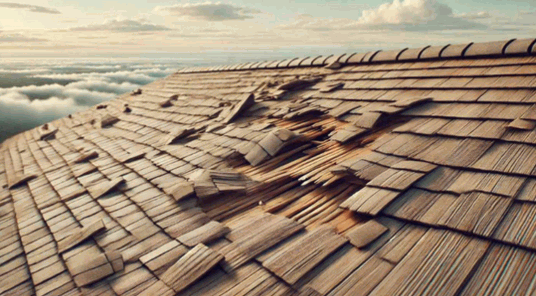A leaking roof can present significant challenges for homeowners, resulting in costly repairs and potential water damage to the property. Understanding the common causes of roof leaks is crucial for effective prevention and timely intervention, helping to prevent leaks before they cause serious damage. Issues ranging from damaged shingles to clogged gutters require prompt identification as the initial step in safeguarding the home. This guide examines the primary causes of roof leaks, outlines signs to monitor, and provides actionable solutions for both temporary repairs, such as using roofing sealant or tarpaulin fixes, and permanent fixes. By addressing these concerns, homeowners can alleviate roofing issues, minimize damage, and achieve peace of mind.
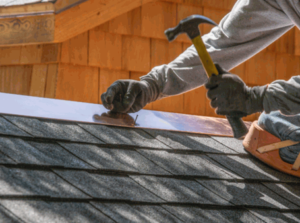
What Causes A Roof To Leak?
A roof leak may occur due to a variety of factors, often resulting in significant water damage if not addressed in a timely manner. Common causes include:
Factors such as storm damage and improper installation may also contribute.
- damaged or missing roof shingles
- clogged gutters
- cracked roofing flashing
- improperly installed skylights
- ice damming
It is essential for homeowners to understand these issues to safeguard their property from the expensive repairs associated with roof leaks and to take proactive measures such as regular roof inspections. Identifying the underlying cause of a leak is critical for implementing effective solutions and appropriate roofing materials, whether through temporary repairs or permanent fixes.
Damaged Or Missing Shingles
Damaged or missing roof shingles represent one of the primary causes of roof leaks, thereby exposing the underlying structure to water infiltration and potentially significant damage over time. It is imperative to recognize the signs of this roofing issue promptly, as neglecting to address it may lead to more extensive repairs in the future, including potential drywall damage.
Homeowners should conduct regular inspections of their roofs to identify any abnormalities, such as curling, lifting, or broken shingles. These issues may arise from severe weather conditions or simply the natural aging of materials. Furthermore, considering the impact of debris accumulation, ensuring proper installation techniques, and utilizing quality roofing materials can significantly contribute to maintaining the integrity of a roof to prevent plumbing issues.
By proactively engaging in roofing maintenance and performing thorough inspections, including attic inspection, individuals can effectively mitigate the risk of leaks and avoid costly damages.
When shingles are compromised, their protective function is diminished, allowing water to seep through gaps, which can potentially lead to mold growth and damage to the interior of the home. Homeowners often overlook the fact that even a few missing or damaged shingles can escalate issues over time, potentially leading to chimney leaks and mold growth. Therefore, it is essential to understand the importance of timely repairs.
Common methods for addressing these problems include:
- Replacing damaged shingles with new ones made from durable materials such as asphalt or metal.
- Using sealant or roofing tape to temporarily patch smaller areas of wear.
- Hiring professional roofers for comprehensive inspections and repairs to ensure the longevity of the roof.
By adhering to these strategies and remaining vigilant regarding roofing conditions, homeowners can proactively protect their investment while enhancing the value of their property.
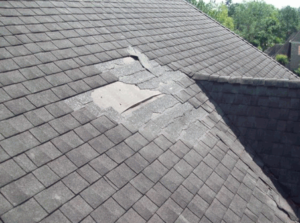
Clogged Gutters
Clogged gutters can significantly contribute to roof leaks by obstructing proper drainage. This obstruction can cause water to pool and eventually seep into roofing materials, leading to more than merely unsightly water stains on the ceiling; it poses a genuine threat to the structural integrity of the home.
When gutters become obstructed with leaves, twigs, and debris, the resulting water accumulation can overwhelm the roofing system, leading to serious complications such as:
- Increased pressure on the roofing structure, can cause tiles or shingles to lift, allowing rainwater to infiltrate beneath.
- The formation of ice dams in colder climates, where melting snow refreezes at the roof’s edge, forcing water back underneath the roofing material.
- Persistent moisture can foster mold and mildew growth, presenting serious health hazards for occupants.
Therefore, regular maintenance and effective cleaning strategies for gutters are essential. Homeowners are advised to inspect their gutters at least twice a year, removing any obstructions to ensure unobstructed flow, thereby mitigating the risk of leaks and costly water damage.
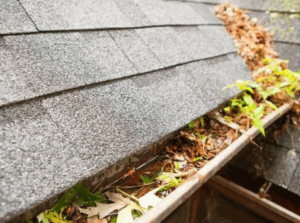
Cracked Flashing
Cracked roofing flashing is a significant contributor to roof leaks, as it undermines the waterproof barrier surrounding chimneys, vents, and other protrusions on the roof. If left unaddressed, this condition can lead to extensive water damage, which may considerably increase repair costs over time.
When addressing cracked or deteriorating flashing, it is essential to understand both its function and the common locations susceptible to damage. The most prevalent areas where flashing issues occur include:
- Chimney bases
- Wall intersections
- Skylights
- Roof valleys
- Vent pipes
These locations are particularly vulnerable due to their constant exposure to various weather elements. The process for repairing cracked flashing generally involves the following steps:
- Inspect the area to evaluate the extent of the damage.
- Remove any compromised sections of the flashing.
- Install new flashing using appropriate sealing materials.
It is often recommended to consult a professional roofing company for installation or repair, as they possess the necessary expertise to ensure a proper seal and mitigate the risk of future leaks.
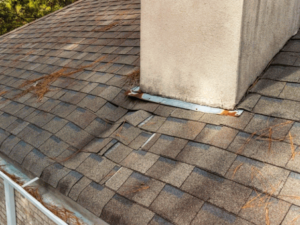
Improperly Installed Skylights
Improperly installed skylights can result in significant leaks, primarily due to inadequate sealing and flashing, which allows moisture to infiltrate the roof structure.
The ramifications of such errors can be considerable, leading not only to water damage but also adversely affecting the overall energy efficiency of the building. When contemplating the installation of skylights, it is crucial to recognize that even minor missteps can result in costly repairs and extensive damage.
Common mistakes include:
- Neglecting proper measurements, which adversely affect fit and waterproofing,
- Utilizing inadequate sealing materials that compromise structural integrity,
- Improper installation of flashing can lead to water pooling and subsequent leakage.
These issues can often be addressed by consulting roofing experts who specialize in the correct installation of skylights. These professionals possess the necessary knowledge and experience to resolve roofing problems efficiently, ensuring that appropriate materials and techniques are utilized to prevent future complications.
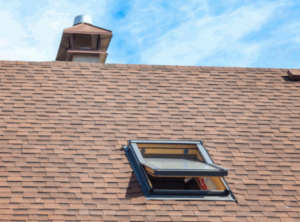
Ice Dams
Ice damming occurs when melting snow refreezes at the edge of the roof, creating a barrier that obstructs proper drainage and can lead to substantial water damage within the attic and roof structure.
This issue predominantly arises during freezing temperatures when accumulated snow on the roof begins to melt due to heat escaping from the interior of the house. As the melted water flows down the slope, it may encounter the colder edge of the roof, resulting in refreezing and the formation of a dam. If not addressed, this condition can ultimately force water back beneath the roofing materials, thereby compromising the integrity of the roof.
Several factors can contribute to this problem, including:
- Inadequate insulation in the attic, which allows excess heat to escape.
- Poor ventilation, which fails to effectively regulate temperatures.
- The necessity of conducting regular attic inspections to maintain the health of the roof.
To mitigate ice damming, homeowners should consider implementing roofing solutions such as enhancing insulation levels and ensuring that ventilation systems operate efficiently. These proactive measures not only help prevent the formation of ice dams but also significantly contribute to the overall durability of the roof structure.
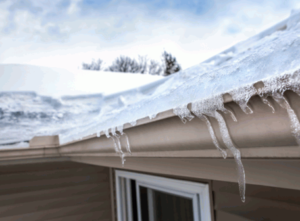
How To Identify A Roof Leak?
Identifying a roof leak requires careful observation of various signs and symptoms indicative of water infiltration, which is essential for preventing further damage.
Common indicators of a roof leak include:
- Water spots on ceilings or walls,
- A damp or musty odor,
- Visible water dripping, and
- Sagging or bulging ceilings.
Homeowners are also advised to inspect the attic for any signs of moisture and mold growth. Early detection and accurate identification of leaks are crucial in facilitating timely action, thereby minimizing damage and preserving the integrity of the roof.
Water Stains On Ceiling Or Walls
Water stains on ceilings or walls often serve as the initial visible indicators of a leaking roof, signifying potential water damage that necessitates immediate attention. These stains can present themselves in various shapes and sizes, ranging from small brown spots to large, spreading patches that suggest significant moisture accumulation over time, requiring immediate roofing repairs.
Interpreting the implications of these stains is essential, as they can provide valuable insights into the roof’s condition and help identify potential leak points.
- Light brown stains may suggest a minor leak, while dark brown or yellow stains can indicate prolonged exposure to water.
- The presence of mold or mildew in these areas frequently points to ventilation issues or extended moisture retention, which might necessitate roofing tar application for repairs.
Recognizing these indicators enables homeowners to prioritize timely roof inspections and maintenance. Regular evaluations assist in identifying leaks early, thereby preventing further damage, reducing the risk of costly roof repairs, and ensuring effective roof performance in rainstorms.
Homeowners should not disregard these signs; addressing them promptly can conserve both time and financial resources, thereby ensuring the longevity of the roofing system.
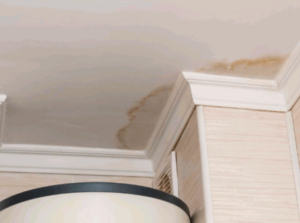
Damp Or Musty Smell
A damp or musty odor within a residence often indicates the presence of water damage, which may be associated with a roof leak that necessitates thorough inspection, possibly revealing issues such as damaged pipe boots or clogged gutters debris.
This concerning smell typically suggests that moisture has entered areas intended to remain dry, resulting not only in unsightly and damaging mold growth but also in potential health risks for occupants.
Identifying the source of this odor is imperative; homeowners are encouraged to investigate commonly overlooked areas such as the attic, crawl spaces, and even the basement, where water may accumulate undetected.
- Begin by inspecting the roof for missing or damaged shingles that could permit rainwater to infiltrate.
- Examine gutters and downspouts to ensure they are clear of debris and effectively directing water away from the foundation.
- Check for leaks around windows and doors, and assess the integrity of flashing around chimneys or vents.
Implementing regular maintenance checks and addressing issues promptly can assist in mitigating severe structural damage and avoiding costly roof repairs in the future.
Visible Water Dripping Or Puddles
Visible water dripping or the presence of puddles within the home are clear indicators of a roof leak that must be addressed promptly to prevent further damage.
These concerning signs not only suggest the existence of a leak but may also indicate potential underlying issues with the roofing structure that could deteriorate over time. Homeowners should remain vigilant in identifying possible sources of water accumulation, such as clogged gutters or damaged shingles.
Regular maintenance, which includes the removal of debris and the prompt execution of repairs, can significantly extend the lifespan of the roof. To manage visible leaks effectively, it is essential to conduct timely inspections of the roof, ideally following severe weather events or on a seasonal basis.
Addressing these concerns proactively safeguards the home and helps to avoid costly repairs in the future. Consider the following actions, including using DIY repairs for minor issues or calling a professional for severe situations:
- Take note of any areas where water accumulates.
- Inspect around chimneys, vents, and skylights for signs of wear.
- Be mindful of the age and condition of your roofing materials.
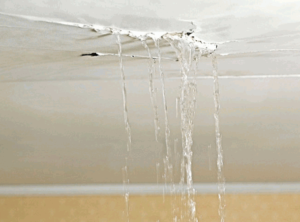
Sagging Or Bulging Ceiling
A sagging or bulging ceiling may serve as a significant indicator of underlying water damage, frequently stemming from prolonged leaks that jeopardize the structural integrity of the building and could require immediate roofing advice and waterproofing covering applications.
Such symptoms may suggest roofing problems that could escalate into serious structural issues if not addressed in a timely manner. Homeowners should remain vigilant when noticing these concerning changes, as they often signify a larger issue, such as deteriorating shingles or failing flashing.
If these problems are left untreated, they can lead to expensive repairs and may even require a complete roof replacement. Regular inspections and timely maintenance are not merely advisable; they are essential for:
- Ensuring safety
- Extending the lifespan of the roof
- Preventing unforeseen expenses
Additionally, it is crucial to identify the source of water intrusion as early as possible; neglecting these signs can lead to mold growth and further complications.
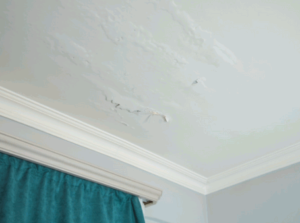
How To Stop A Roof Leak Temporarily?
Temporarily addressing a roof leak is crucial to mitigate damage until a permanent solution can be implemented. Homeowners may employ various methods, such as utilizing a tarp or PE plastic to cover the affected area, applying roofing tar to seal any gaps, or using waterproof materials like polyethylene plastic to redirect water away from the leak.
These temporary repairs can offer immediate relief and help prevent further water damage, thereby allowing homeowners the necessary time to schedule a professional assessment and arrange for lasting repairs.
Uncover more: Can You Paint Roof Tiles
Use A Tarp
Utilizing a tarp covering represents one of the most effective temporary solutions for addressing a roof leak, as it offers immediate protection against additional water damage and acts as a waterproof covering for the roofing structure.
To ensure the tarp adequately covers the leak while remaining secure against wind and rain, several key steps must be followed. First, it is important to assess the area surrounding the leak and determine the appropriate tarp size required to fully span the damaged section without any overhang that could catch the wind. When applying the tarp, it is crucial to position it in such a way that water drains off the edge, thereby preventing pooling.
Safety measures must be prioritized; it is advisable to use a sturdy ladder, wear a safety harness when working on a pitched roof, and secure the tarp tightly using ropes or bungee cords. Additionally, it is important to consider the following precautions:
- Ensure there are no overhead hazards before climbing.
- If possible, work with a partner, as an extra set of hands can assist in maintaining stability.
By adhering to these practices, individuals can effectively protect their homes until a permanent repair can be implemented, thereby mitigating potential complications and expenses.
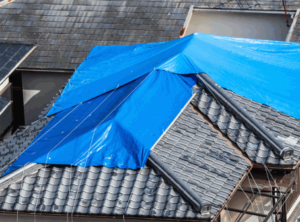
Apply Roofing Cement
Applying roofing cement or roofing tar represents an efficient method for sealing small leaks and gaps, providing an immediate barrier against water infiltration. This effective sealing technique is particularly beneficial for various roofing materials, including asphalt, shingles, and metal roofs, enabling homeowners to address issues without necessitating a complete roof overhaul.
When confronted with small cracks or punctures, appropriate application can prevent further damage resulting from moisture accumulation. To successfully apply roofing cement, it is essential to ensure that the area is clean and dry, removing any debris or loose material. Additionally, it is imperative to wear protective gloves and to work in a well-ventilated environment due to the strong fumes associated with the product.
- Select the correct type of roofing cement suitable for your specific roofing material.
- Apply the cement generously over the affected area, extending a few inches beyond the leak.
- For improved adhesion, consider utilizing a putty knife or a trowel.
Furthermore, it is advisable to avoid applying roofing cement during extreme weather conditions, such as heavy rain or intense heat, to ensure proper curing and effectiveness.
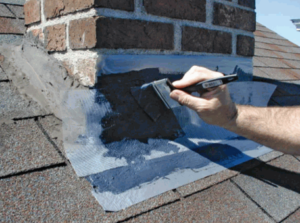
Use A Rubber Patch
Utilizing a rubber patch can be an effective temporary solution for roof leaks, particularly in areas exhibiting minor damage or holes. This method provides homeowners and maintenance professionals with a prompt and efficient approach to address unforeseen issues while they consider long-term roofing alternatives.
When contemplating the application of a rubber patch, it is crucial to adhere to specific procedures to ensure optimal effectiveness. The surface surrounding the damage must be thoroughly cleaned to remove any debris or loose materials.
Following the cleaning process, the rubber patch should be meticulously applied to cover the affected area, with adhesive employed to secure it firmly. This seamless application facilitates a waterproof barrier that can protect against further water intrusion.
Some advantages of this method include:
- Quick application, making it suitable for emergency situations.
- Cost-effectiveness in comparison to more extensive repair methods.
- Enhanced resistance to harsh weather conditions, contributing to longevity.
However, it is important to acknowledge certain limitations, such as the potential for deterioration over time and the fact that this method is intended as a temporary fix. For enduring solutions, more comprehensive repairs or replacements may be required.
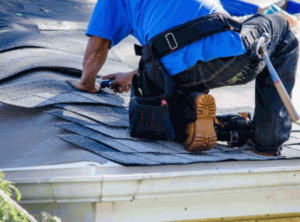
How To Repair A Leaking Roof Permanently?
To achieve a permanent resolution for a leaking roof, homeowners are advised to adopt a systematic approach, which typically involves engaging a reputable roofing company for a professional assessment. This may include installing new shingles or repairing leaks to maintain the roof’s integrity.
Permanent solutions may encompass:
- Replacing damaged shingles,
- Sealing flashing,
- Cleaning gutters, and
- Ensuring the proper installation of roofing materials.
These measures not only address existing leaks but also enhance the overall longevity and effectiveness of the roof, thereby reducing the likelihood of future roofing issues.
Replace Damaged Shingles
Replacing damaged shingles is an essential step in the permanent repair of a leaking roof, as it reinstates the protective layer and prevents further water intrusion. This process commences with a comprehensive inspection to identify any shingle damage, which may result from factors such as severe weather, aging, or improper installation. Homeowners should remain vigilant for signs such as curling, cracking, or missing shingles, as these may indicate underlying issues requiring immediate attention, and they may need to identify leak sources promptly.
Utilizing high-quality roofing materials not only enhances the durability of the roof but also contributes positively to the overall aesthetic appeal of the home. It is advisable to seek professional guidance throughout this process to ensure proper techniques are employed, thereby avoiding common mistakes that could exacerbate the situation. The use of reliable roofing solutions, including effective covering materials, can significantly extend the lifespan of the roof and diminish the likelihood of future leaks.
- Identify damaged shingles promptly.
- Use high-quality materials for replacements.
- Consult professionals for effective solutions.
Engaging with experts can provide clarity regarding the best options available, ensuring that decisions made will benefit the long-term health of the roof. For those considering DIY repairs, it is crucial to be aware of the necessary steps to fix leaks effectively.
Clean Gutters And Downspouts
Maintaining clean gutters and downspouts is essential for preventing leaks, as clogged gutters can lead to water pooling and potential damage to the roof structure.
Regular maintenance of gutters not only safeguards the integrity of the roof but also extends the lifespan of the overall roofing system. Properly functioning gutters are critical for channeling rainwater away from the home, thereby preserving both the roof and the foundation. Neglecting this important task can result in a range of issues, including potential flooring protection concerns due to water intrusion:
- Water damage to interior walls and ceilings
- Mold growth, which poses significant health risks
- Foundation erosion due to excess water
To effectively clean gutters, homeowners are advised to utilize a sturdy ladder, wear appropriate gloves, and manually remove leaves and debris or employ a scoop. Following this, a garden hose can be used to flush out any remaining particles and ensure that downspouts remain unobstructed. This is an important step in overall home maintenance.
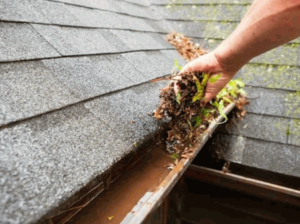
Seal Cracked Flashing
Sealing cracked flashing is essential for establishing a watertight seal around chimneys and vents, thereby preventing leaks from infiltrating the roof.
Failing to adequately address flashing issues can result in more severe damage over time, including structural deterioration and mold growth, both of which can incur significant repair costs. It is essential to track leak origins and consider utilizing high-quality materials, such as:
- Polyurethane sealant, which provides strong adhesion and flexibility.
- Sheet metal flashing for enhanced durability and protection.
- Modified bitumen membranes, which are particularly effective in high-traffic areas.
When sealing, it is imperative to ensure that the surfaces are clean and dry area to achieve optimal adhesion. Employing these roofing solutions not only extends the lifespan of the roof but also enhances overall performance, substantially mitigating the risk of water leaks and maintaining a secure home environment.
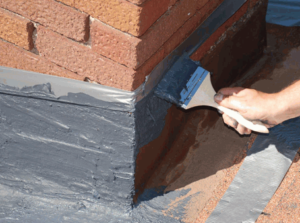
Reseal Skylights
Resealing skylights is a vital procedure in preventing leaks, particularly when the existing seal has deteriorated over time. This essential maintenance task significantly contributes to the structural integrity of the roof and serves to protect the home from water damage, mold growth, and potentially costly repairs in the future.
Many homeowners tend to underestimate the importance of this procedure, which can lead to various issues associated with improperly installed or maintained skylights. Such problems may include:
- Increased energy costs due to heat loss or gain
- Water intrusion resulting in ceiling stains and structural decay
- Compromised insulation performance
To mitigate these risks, it is imperative to consult with a professional roofing company. These experts possess the necessary knowledge to identify potential weaknesses in the installation and to ensure that proper sealing techniques are employed.
By adopting this proactive approach, homeowners can enhance the longevity and efficiency of their skylights while minimizing future maintenance concerns.
Install Ice And Water Shield
Installing an ice and water shield constitutes a proactive measure that can significantly mitigate the risk of leaks caused by ice damming during the winter months, thereby ensuring long-term protection against moisture damage.
This protective roofing material serves as a barrier, safeguarding roofing systems from harsh environmental elements. By incorporating an ice and water shield, homeowners not only enhance the durability of their roofs but also contribute to improved leak prevention strategies, especially in areas like Orlando.
Below is a concise overview of the benefits and installation process:
Benefits:
- Reduces the likelihood of leaks during winter.
- Extends the lifespan of roofing materials.
- Improves energy efficiency by maintaining appropriate insulation.
Installation Process:
- Inspect the roof for damages and ensure a clean surface. It is crucial to inspect attic spaces for any signs of water damage.
- Unroll the ice and water shield along the eaves and valleys of the roof.
- Secure the shield using nails or adhesive, as specified by the product guidelines.
- Proceed with the installation of shingles or other roofing materials on top. For added protection, consider using PE plastic as a temporary cover during installation.
By prioritizing the installation of such a protective layer, maintaining the integrity and performance of the roof throughout the year becomes significantly more manageable.
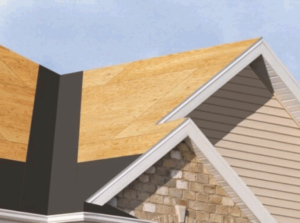
Inspect And Repair Roof Vents
Inspecting and repairing roof vents is essential for preventing leaks, as damaged or improperly installed vents can lead to significant water intrusion, compromising the integrity of the entire roofing system and resulting in costly repairs in the future. It’s important for roofing safety to ensure these tasks are handled with care.
Regular inspections of roof vents facilitate the early identification of potential issues, allowing for proactive maintenance. Homeowners should remain vigilant for common indicators of problems, including the need to repair leaks:
- Visible cracks or breaks in the vent material
- Loose or detached vents
- Signs of rust or corrosion
- Accumulation of debris in or around the vents
Timely attention to these issues is crucial, as neglecting them can result in water damage, mold growth, and structural failures. The effectiveness of insulation and overall energy efficiency is reliant on the proper functioning of these vents. Therefore, prompt repairs and maintenance are vital for ensuring a durable and healthy roofing system.
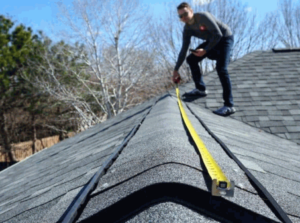
Hire A Professional Roofing Contractor
Hiring a professional roofing contractor is frequently the most prudent choice for homeowners encountering significant roof leaks, as it ensures expert analysis and repair. Sometimes, it’s necessary to call professional services to adequately address roof condition issues.
When faced with such issues, it is essential to recognize that the expertise provided by seasoned professionals can play a crucial role in safeguarding the home. Engaging skilled roofing services presents numerous advantages, including:
- Thorough Assessment: Experts perform comprehensive evaluations to identify not only the existing damage but also potential future risks, ensuring the roof condition is thoroughly analyzed.
- Quality Materials: Professionals have access to superior materials that ensure durability and longevity.
- Time Efficiency: Their experience allows the team to conduct repairs promptly, thereby minimizing disruptions to daily life.
- Warranties and Insurance: Reputable companies typically offer warranties and are insured, providing peace of mind regarding the work completed.
In the process of selecting a roofing company, it is imperative to assess various factors such as industry reputation, customer reviews, and certifications. The significance of expert knowledge cannot be overstated, as it directly correlates with maintaining roof integrity and ensuring that your investment is adequately protected against the elements.
This careful consideration in choosing the right professional can ultimately lead to a more secure and resilient home.

